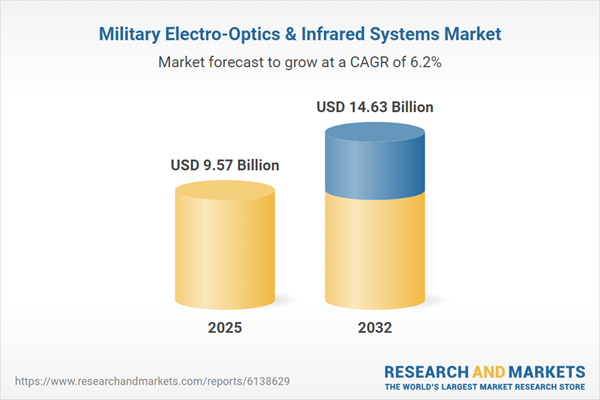Speak directly to the analyst to clarify any post sales queries you may have.
The Military Electro-Optics and Infrared Systems Market is transforming the landscape of global defense. Senior industry leaders are seeking actionable insight as advanced sensors, imaging platforms, and analytics reshape intelligence and operational decision-making.
Market Snapshot: Military Electro-Optics and Infrared Systems
Driven by continual investments in sensor innovation and integrated surveillance platforms, the market for military electro-optics and infrared systems expanded from USD 9.03 billion in 2024 to USD 9.57 billion in 2025. With a projected CAGR of 6.21%, the sector is anticipated to reach USD 14.63 billion by 2032. Dynamic procurement cycles and rising requirements for persistent situational awareness, border security, and networked operations support sustained demand across all major regions and end user groups.
Scope & Segmentation of the Military Electro-Optics and Infrared Systems Market
This research provides a comprehensive analysis by examining the full value chain, from component innovation to end-user platform deployment. Detailed segmentation is as follows:
- Component: Photon Detectors (HgCdTe, InGaAs, QWIP), Thermal Detectors (Microbolometer, Pyroelectric), Electronics, Optics, Software
- Cooling Type: Cooled, Uncooled
- Wavelength: LWIR, MWIR, NIR, SWIR, Visible
- Product: EO/IR Sensors, IR Cameras (Fixed, PTZ), Laser Rangefinders, Night Vision Goggles (Gen I, II, III), Thermal Imagers (Gimbal Mounted, Handheld, Helmet Mounted)
- Application: Fire Control, Navigation, Reconnaissance, Surveillance (Battlefield, Border, Maritime), Target Acquisition
- Platform: Airborne (Fixed-Wing, Rotary-Wing, UAV), Ground (Man-Portable, Stationary, Vehicle-Mounted), Naval, Space
- Region: Americas (North America, Latin America), Europe Middle East & Africa (Europe, Middle East, Africa), Asia-Pacific
- Company Coverage: Airbus SAS, Amentum Services, Aselsan, BAE Systems, Bharat Electronics, CONTROP Precision Technologies, Corning, Elbit Systems, General Dynamics, Hensoldt, HGH Infrared Systems by TTP, IMSAR, Israel Aerospace, Kollmorgen, Kongsberg Gruppen, L3 Harris Technologies, Leonardo, Lockheed Martin, MBDA Missile Systems, Northrop Grumman, Ophir Optronics, Rafael Advanced Defense Systems, Raytheon Technologies, Rheinmetall, Saab, Safran, Teledyne FLIR, Thales, Boeing
Key Takeaways: Strategic Insights for Senior Leaders
- Electro-optics and infrared systems are now foundational enablers of intelligence and battlefield dominance, with rapid technological convergence shaping deployment priorities.
- Nations are prioritizing integration of multispectral sensors, laser rangefinding, and AI-enabled analytics for advanced networked combat capabilities and enhanced threat detection.
- Geopolitical shifts and accelerated defense programs in maritime, airborne, and ground platforms are driving sustained R&D investment, especially for resilience in contested operating environments.
- Segment dynamics favor modular architectures and open systems that support swift upgrades, interoperability between allied forces, and tailored solutions for diverse mission needs.
- Collaborations and partnerships between defense primes and technology specialists are expediting sensor innovation, miniaturization, and multi-domain platform integration across regions.
Tariff Impact: U.S. Trade Policy and Supply Chain Realignment
The introduction of United States tariffs in 2025 prompted notable changes across the defense supply chain for military electro-optics and infrared technology. Increased costs for vital components led to new sourcing initiatives, the localization of manufacturing, and greater attention to modular product architectures. Strategic adjustments are catalyzing investment in supply resilience and accelerating qualification of alternative suppliers, particularly for photon detectors and microbolometer materials.
Methodology & Data Sources
This analysis draws on a mix of primary research—including interviews with defense procurement officials and sensor technologists—and secondary sources, such as patent reviews and regulatory filings. All market findings are validated via technical performance assessments, regional policy analysis, and peer review to ensure robust and actionable intelligence.
Why This Report Matters
- Offers targeted insights to inform capital allocation and technology procurement strategies in a complex, evolving defense market.
- Profiles key competitive players and technology pathways, enabling informed partnerships and R&D planning.
- Supports executive decisions by connecting regulatory shifts, supply chain risk, and innovation trajectories to real-world operational implications.
Conclusion
With military electro-optics and infrared systems assuming a pivotal role in the future of global defense, leaders equipped with strategic, data-driven insight can confidently advance operational capabilities. Ongoing technological innovation and regional focus are essential for sustaining secure and resilient defense operations.
Table of Contents
3. Executive Summary
4. Market Overview
7. Cumulative Impact of Artificial Intelligence 2025
Companies Mentioned
The companies profiled in this Military Electro-Optics & Infrared Systems Market report include:- Airbus SAS
- Amentum Services, Inc.
- Aselsan A.S
- BAE Systems plc
- Bharat Electronics Ltd.
- CONTROP Precision Technologies Ltd.
- Corning Incorporated
- Elbit Systems Ltd.
- General Dynamics Corporation
- Hensoldt AG
- HGH Infrared Systems by TTP PLC
- IMSAR LLC
- Israel Aerospace Industries Ltd.
- Kollmorgen Corporation
- Kongsberg Gruppen ASA
- L3 Harris Technologies, Inc.
- Leonardo S.p.A.
- Lockheed Martin Corporation
- MBDA Missile Systems
- Northrop Grumman Corporation
- Ophir Optronics Solutions Ltd.
- Rafael Advanced Defense Systems Ltd.
- Raytheon Technologies Corporation
- Rheinmetall AG
- Saab AB
- Safran Group
- Teledyne FLIR LLC
- Thales Group
- The Boeing Company
Table Information
| Report Attribute | Details |
|---|---|
| No. of Pages | 185 |
| Published | November 2025 |
| Forecast Period | 2025 - 2032 |
| Estimated Market Value ( USD | $ 9.57 Billion |
| Forecasted Market Value ( USD | $ 14.63 Billion |
| Compound Annual Growth Rate | 6.2% |
| Regions Covered | Global |
| No. of Companies Mentioned | 30 |









